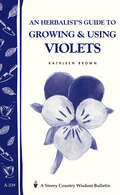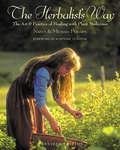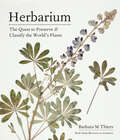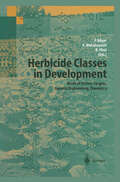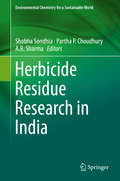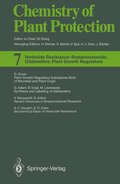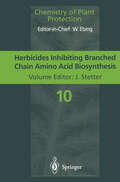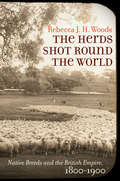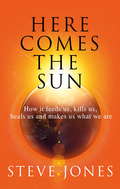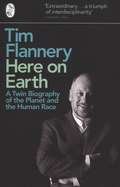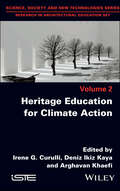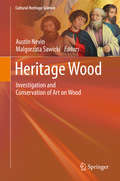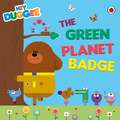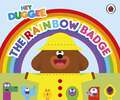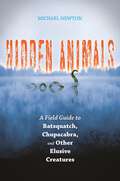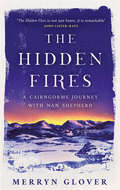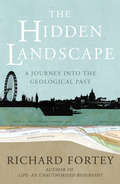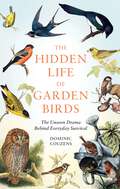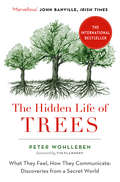- Table View
- List View
An Herbalist's Guide to Growing & Using Violets
by Kathleen BrownSince 1973, Storey's Country Wisdom Bulletins have offered practical, hands-on instructions designed to help readers master dozens of country living skills quickly and easily. There are now more than 170 titles in this series, and their remarkable popularity reflects the common desire of country and city dwellers alike to cultivate personal independence in everyday life.
The Herbalist's Way: The Art and Practice of Healing with Plant Medicines
by Nancy Phillips Michael Phillips Rosemary GladstarThis updated edition of The Village Herbalist provides a complete guide to the art and practice of herbalism, as well as an introduction to the herbalist's role in family and community life. Inspirational profiles of practicing herbalists from across the country add a human touch to the authors' wealth of practical herbal knowledge. The Herbalist's Way includes time-honored healing wisdom from many cultures, as well as information on: • Roles and responsibilities of herbalists in their communities • Herbal workshops, conferences, and education centers • Growing, drying, and preparing medicinal herbs • Learning to listen to clients and recommend holistic treatments for healing and continued wellness • Licensing, marketing, and other legal and business issues facing modern herbalists • Comprehensive resources and suggestions for building your herbal library
Herbarium: The Quest to Preserve and Classify the World's Plants
by Barbara M. ThiersA heavily illustrated history of herbaria from one of the world's foremost experts.
Herbicide Classes in Development: Mode of Action, Targets, Genetic Engineering, Chemistry
by Peter Böger Ko Wakabayashi Kenji HiraiChemical pest control is in use in practically every country in the world since agrochemicals play a decisive role in ensuring food supply and protection against damage by pests, insects and pathogenic fungi. Particularly in the half century since World War II, food production has risen dramatically in most parts of the world. In the last 20 years, the yield of major crops has roughly doubled in Western agriculture and there is still the potential for further achievements, particularly in the developing countries. The world's cereal and rice production, now more than 2 billion tons/year, has to increase by 2. 4% annually to cope with the rising food demand caused mainly by the growing population and improvement of living standards in most of the developing countries. Such a demand for food has to be achieved by higher yields from the restricted arable land already in use. Global farm land resources are about 1. 4 billion ha, of which 1. 2 billion ha is cultivated with major crops. Experts agree that a future substantial addition of new produc tive areas is unlikely. Those with a high yield potential are already in use; new fields with a lower output may possibly be obtained by cultivation of arid or cold areas. More recently, new areas of large-scale farmland have been devel oped in tropical regions of Latin America, primarily in Argentina and Brazil, at the cost of the destruction of tropical rain forest.
Herbicide Residue Research in India (Environmental Chemistry for a Sustainable World #12)
by Shobha Sondhia Partha P. Choudhury A. R. SharmaHerbicides constitute about 60% of the total pesticides consumed globally. In India, the use of herbicides started initially in tea gardens and picked up in the 1970s, when the high-yielding varieties of rice and wheat were introduced. Presently, 67 herbicides are registered in the country for controlling weeds in crops including cereals, pulses, oilseeds, fibre and tuber crops, and also in the non-crop situations. These chemicals are becoming increasingly popular because of their efficiency and relatively low cost compared with manual or mechanical weeding operations. The contribution of herbicide to total pesticide use, which was only 10-15% during the first decade of the 21st century, has now increased to about 25% with an annual growth rate of 15-20%, which is much higher than insecticides and fungicides. Though the application of herbicides is minimizing yield loss to a great extent, their residues in the food chain and surface and groundwater create some environmental nuisance particularly to non-target organisms. Research on pesticide residues in India was started during 1970s, when such chemicals were introduced on a greater scale along with high-yielding variety seeds, irrigation and chemical fertilizers for increasing food production. However, the herbicide residue research was not given much emphasis until 1990s. The Indian Council of Agricultural Research initiated a national level programme known as All India Coordinated Research Project on Weed Management through the NRC-Weed Science as the main centre along with some centers of ICAR Institutes and state agricultural universities. Over the last two decades, adequate information was generated on estimation, degradation and mitigation of herbicide residues, which were documented in annual reports, bulletins, monographs and scientific articles. However, there was no consolidated compilation of all the available information providing a critical analysis of herbicide residues. Accordingly, an effort has been made in the publication to compile the available information on herbicide residues in India. This is the first report of its kind which presents the findings of herbicide residues and their interactions in the biotic and abiotic environment. There are 16 chapters contributed by the leading herbicide residue scientists, each describing the present status of herbicide use, crops and cropping systems, monitoring, degradation and mitigation, followed by conclusions and future lines of work.This book will be useful to the weed scientists in general and herbicide residue chemists in particular, besides the policy makers, students and all those concerned with the agricultural production in the country.
Herbicide Resistance — Brassinosteroids, Gibberellins, Plant Growth Regulators (Chemistry of Plant Protection #7)
by G. Adam S. O. Duke D. Gross M. Lischewski V. Marquardt K. C. Vaughn B. VoigtChemistry of Plant Protection, Volume 7, provides critical review articles on new aspects of herbicide resis- tance, serving the needs of research scientists, pesticide manufacturers, government regulators, agricultural practitioners.
Herbicides Inhibiting Branched-Chain Amino Acid Biosynthesis: Recent Developments (Chemistry of Plant Protection #10)
by H. M. Brown J. C. Cotterman M. W. Drewes G. J. DeBoer S. K. Gee B. C. Gerwick J. V. Hay W. A. Kleschick D. W. Ladner F. Lieb U. Philipp J. V. Schloss P. R. SchmitzerChemicals inhibiting the biosynthesis of branched-chain amino acids form a new and promising class of herbicides. This volume discusses in an authoritative way recent developments in this field and covers important aspects of these potent herbicides (synthesis, structure-activity, mode of action, selectivity, weed resistance, metabolism).
The Herds Shot Round the World: Native Breeds and the British Empire, 1800–1900 (Flows, Migrations, and Exchanges)
by Rebecca J. WoodsAs Britain industrialized in the early nineteenth century, animal breeders faced the need to convert livestock into products while maintaining the distinctive character of their breeds. Thus they transformed cattle and sheep adapted to regional environments into bulky, quick-fattening beasts. Exploring the environmental and economic ramifications of imperial expansion on colonial environments and production practices, Rebecca J. H. Woods traces how global physiological and ecological diversity eroded under the technological, economic, and cultural system that grew up around the production of livestock by the British Empire. Attending to the relationship between type and place and what it means to call a particular breed of livestock "native," Woods highlights the inherent tension between consumer expectations in the metropole and the ecological reality at the periphery.Based on extensive archival work in the United Kingdom, New Zealand, and Australia, this study illuminates the connections between the biological consequences and the politics of imperialism. In tracing both the national origins and imperial expansion of British breeds, Woods uncovers the processes that laid the foundation for our livestock industry today.
Here Comes the Sun
by Jo Clegg'A warm, nurturing, optimistic, sunny story.' Sue Teddern, author of Annie Stanley, All at SeaIt's never too late for a new beginning...Steph Herrington runs a successful hair salon - she can make your hair look amazing but she's no gardener. An allotment was her late husband's dream. But when her daughter, Jessie, decides to take the plot on in her dad's memory, Steph sees a chance to bridge the gulf that grew between them as their loving, close-knit family fell apart... Only the gnarly tangle of weeds and thorns - and working together to tame it - is much harder than they'd imagined. But as winter turns to spring and fruits and vegetables start to flourish - and with the support of Jessie's loyal friend, Hog, and handsome fellow plot-holder and single dad, Richard - can Steph and Jessie's relationship grow back stronger than ever?A heartwarming and uplifting novel about community, family, and finding yourself again after a loss. Perfect for fans of Catherine Alliot, Fanny Blake and Fiona Gibson.
Here Comes the Sun: How it feeds us, kills us, heals us and makes us what we are
by Professor Steve JonesOur sun drives the weather, forms the landscape, feeds and fuels - but sometimes destroys - the creatures that live upon it, controls their patterns of activity, makes chemicals in the skin that cheer up those who bask in its rays, and for the ancients was the seat of divine authority.In Here Comes the Sun, Steve Jones shows how life on Earth is ruled by our nearest star. It is filled with unexpected connections; between the need to stay cool and man's ability to stand upright, between the power of memory and the onset of darkness, between the flow of solar energy through the plants and animals and of wealth through society, and between Joseph Goebbel's 1938 scheme to make Edinburgh the summer capital of a defeated Britain and the widening gap in the life expectancy of Scottish men compared to that of other European men brought on by thnat nation's cloudy climate. Its author charts some of his own research in places hot and cold across the globe on the genetic and evolutionary effects of sunlight on snails, fruit-flies and people and shows how what was once no more an eccentric specialism has grown to become a subject of wide scientific, social and political significance. Stunningly evocative, beautifully written and packed full of insight, Here Comes the Sun is Steve Jones's most personal book to date.
Here On Earth: A Twin Biography Of The Planet And The Human Race (PDF)
by Tim FlanneryWhat is our place on Earth? Are humans destined to become a footnote in history, or will we become stronger and wiser, and conquer our environmental problems? In this extraordinary story of our planet and our place upon it, Here on Earth discovers the remarkable source of all life and how it has developed into the wonder around us today. From ant-colonies to zinc mining, Tim Flannery takes us on a journey around the world and from the top of the food-chain to the very chemicals of which we are made, and explores how the fate of humanity is in our own hands.
Heritage Education for Climate Action
by Irene G. Curulli Deniz Ikiz Kaya Arghavan KhaefiCultural heritage is increasingly recognized for its contributions to the transition to climate action, and heritage education can play an important role in developing climate adaptation competencies. These can foster positive dialogs surrounding climate change, shift attitudes and inspire actions. However, achieving these goals requires bridging the gap between policy, practice and local capacity building, as well as integrating a multi- and transdisciplinary approach into traditional higher education curricula and models. Bringing together knowledge, practice and experiences from different disciplinary silos, this book provides a wide set of innovative teaching and learning methods, tools and pedagogical models that can be adapted to heritage education in order to address climate issues. Organized into four parts, Heritage Education for Climate Action covers a wide array of international experiences, real-life cases and practices, focusing on heritage and resilience building, vulnerability and risk assessment, climate change adaptation, mitigation and policymaking. This book is therefore a source of suggestions and ideas for scholars, educators and professionals who want to develop future climate leadership and contribute to the transition of heritage education toward sustainable development and climate action.
Heritage Education for Climate Action
by Irene G. Curulli Deniz Ikiz Kaya Arghavan KhaefiCultural heritage is increasingly recognized for its contributions to the transition to climate action, and heritage education can play an important role in developing climate adaptation competencies. These can foster positive dialogs surrounding climate change, shift attitudes and inspire actions. However, achieving these goals requires bridging the gap between policy, practice and local capacity building, as well as integrating a multi- and transdisciplinary approach into traditional higher education curricula and models. Bringing together knowledge, practice and experiences from different disciplinary silos, this book provides a wide set of innovative teaching and learning methods, tools and pedagogical models that can be adapted to heritage education in order to address climate issues. Organized into four parts, Heritage Education for Climate Action covers a wide array of international experiences, real-life cases and practices, focusing on heritage and resilience building, vulnerability and risk assessment, climate change adaptation, mitigation and policymaking. This book is therefore a source of suggestions and ideas for scholars, educators and professionals who want to develop future climate leadership and contribute to the transition of heritage education toward sustainable development and climate action.
Heritage Wood: Investigation and Conservation of Art on Wood (Cultural Heritage Science)
by Austin Nevin Malgorzata SawickiThis volume highlights recent research efforts in the conservation and investigation of works of art on wood. Through eleven case studies it showcases different experimental methods ranging from X-ray analysis of objects to the study of cross-sections made from micro-samples. New research focusing on the technical study, treatment and assessment of works of art on wood in its many forms is featured in this edited volume. Technical studies include the attribution and investigations of a triptych by Hans Memling and a sculpture from workshop of Michel and Gregor Erhart, decorated Syrian rooms, and investigations of finely carved Gothic wooden objects. Synchrotron-based methods are presented for studying the alteration of 19th c. verdigris in Norway, and multi-analytical methods are employed for the investigations of 16th to 19th c. East Asian lacquer from the Kunsthistorisches Museum in Vienna. Novel methods for the cleaning of gilded surfaces using gels and emulsions are shown, as are innovative strategies for the consolidation for waterlogged wood, providing key data for the assessment of risks and benefits of new methods, and the short and long-term effects on gilding layers and archaeological wood. The book clearly shows how collaboration between engineers, physicists, biologists and chemists and conservators of different types of materials can lead to new research in conservation science. This book is crucial reading for conservators and conservation scientists, as well as for technical art historians, providing key methodological case studies of polychromy from different temporal and geographical contexts.
Heroes of Environmental Diplomacy: Profiles in Courage
by Felix DoddsToday more than ever, when the world is beset by environmental, social, healthcare and economic challenges, we need courage in our politics, both nationally and globally. This book tells the stories, some for the first time, of twelve individuals who made heroic contributions to protecting our planet through ground-breaking international treaties. Can individuals change the world? Today, when impersonal forces and new technologies seem to be directing our lives and even our entire planet in ways we cannot control, this question feels more relevant than ever before. This book argues that we can all make a difference. It tells inspiring stories of individuals who have had a global impact that is beyond dispute, as well as others who have brought about change that is understated or hard to measure, where the scale of the impact will only become clear in years to come. While some are scientists, others are politicians, diplomats, activists, and even businesspeople. However, they all share the qualities of perseverance, patience, a willingness to innovate or try new approaches, and the endurance to continue over years, even decades, to pursue their goal. Drawing on interviews and the inside stories of those involved, each chapter follows one or more of these heroic individuals, a list which includes Luc Hoffmann, Mostafa Tolba, Maria Luiza Ribeiro Viotti, Raul Oyuela Estrada, Barack Obama and Paula Caballero. Presenting an uplifting and gripping narrative, this book is an invaluable resource for students, scholars, activists and professionals who are seeking to understand how consensus is reached in these global meetings and how individuals can have a genuine impact on preserving our planet and reinforcing the positive message that global cooperation can actually work.
Heroes of Environmental Diplomacy: Profiles in Courage
by Felix Dodds Chris SpenceToday more than ever, when the world is beset by environmental, social, healthcare and economic challenges, we need courage in our politics, both nationally and globally. This book tells the stories, some for the first time, of twelve individuals who made heroic contributions to protecting our planet through ground-breaking international treaties. Can individuals change the world? Today, when impersonal forces and new technologies seem to be directing our lives and even our entire planet in ways we cannot control, this question feels more relevant than ever before. This book argues that we can all make a difference. It tells inspiring stories of individuals who have had a global impact that is beyond dispute, as well as others who have brought about change that is understated or hard to measure, where the scale of the impact will only become clear in years to come. While some are scientists, others are politicians, diplomats, activists, and even businesspeople. However, they all share the qualities of perseverance, patience, a willingness to innovate or try new approaches, and the endurance to continue over years, even decades, to pursue their goal. Drawing on interviews and the inside stories of those involved, each chapter follows one or more of these heroic individuals, a list which includes Luc Hoffmann, Mostafa Tolba, Maria Luiza Ribeiro Viotti, Raul Oyuela Estrada, Barack Obama and Paula Caballero. Presenting an uplifting and gripping narrative, this book is an invaluable resource for students, scholars, activists and professionals who are seeking to understand how consensus is reached in these global meetings and how individuals can have a genuine impact on preserving our planet and reinforcing the positive message that global cooperation can actually work.
Hey Duggee: The Green Planet Badge (Hey Duggee)
by Hey DuggeeDuggee and the Squirrels learn about the trees! Its time to earn their Green Planet Badge!The Squirrels are playing outside and wonder about what makes trees so special. So, Duggee has an idea to show them everything trees do for the planet and how best to care for them.A perfectly leafy picture book for little tree huggers everywhere!One last thing... Tree Hugs!Want more Duggee? Also available:Hey Duggee: A Day at the BeachHey Duggee: Get Well Soon NorrieHey Duggee: Duggee and the Magical Unicorn
Hey Duggee: The Rainbow Badge (Hey Duggee)
by Hey DuggeeDuggee and the Squirrels are outside enjoying the rain when suddenly . . . it stops raining, the sun comes out and a beautiful rainbow appears!Join the Squirrels as they learn all about colours and even make their own rainbow. Can you help them find all the right colours?One more thing. . . DUGGEE HUG! Want more Duggee? Also available:Hey Duggee: The Breakfast BadgeHey Duggee: The Shape BadgeHey Duggee: Getting Ready for Bed Badge
Hidden Animals: A Field Guide to Batsquatch, Chupacabra, and Other Elusive Creatures (Non-ser.)
by Michael NewtonA global survey of unknown creatures reported by thousands of eyewitnesses—creatures that have either been verified, refuted, or are still being examined by scientific researchers.Hidden Animals: A Field Guide to Batsquatch, Chupacabra, and Other Elusive Creatures welcomes readers into the fascinating world of cryptozoology—the scientific pursuit of legendary creatures that sometimes reveals hoaxes and sometimes identifies real, previously unknown species. Compiled by Michael Newton, author of the acclaimed Encyclopedia of Cryptozoology, it is the first comprehensive guide covering the crossroads of zoology and folklore written for both the young and the young at heart.Organized by type of creature type, such as giant animals, missing links, and living fossils, Hidden Animals surveys various beings reported and pursued worldwide from ancient times to the present, in every corner of the globe. In the process, it relates classic myths and legends to identified flesh-and-blood animals. Readers will be captivated by both the scientific evidence supporting the existence of specific cryptids and the exposure of notorious frauds or cases of mistaken identity.
The Hidden Company That Trees Keep: Life from Treetops to Root Tips
by James B. NardiA spectacularly illustrated journey into the intimate communities that native trees share with animals, insects, fungi, and microbesYou can tell a lot about a tree from the company it keeps. James Nardi guides you through the innermost unseen world that trees share with a wondrous array of creatures. With their elaborate immune responses, trees recruit a host of allies as predators and parasites to defend against uninvited advances from organisms that chew on leaves, drain sap, and bore into wood. Microbial life thrives in the hidden spaces of leaf scales, twigs, and bark, while birds, mammals, and insects benefit from the more visible resources trees provide. In return, animals help with pollination, seed dispersal, and recycling of nutrients. The Hidden Company That Trees Keep blends marvelous storytelling with beautiful illustrations and the latest science to reveal how the lives of trees are intertwined with those of their diverse companions.Features a wealth of richly detailed drawings accompanied by breathtaking images of microscopic landscapes on leaf, bark, and root surfacesIncludes informative fact boxesDraws on new discoveries in biology and natural historyWritten by one of the world’s leading naturalists
The Hidden Company That Trees Keep: Life from Treetops to Root Tips
by James B. NardiA spectacularly illustrated journey into the intimate communities that native trees share with animals, insects, fungi, and microbesYou can tell a lot about a tree from the company it keeps. James Nardi guides you through the innermost unseen world that trees share with a wondrous array of creatures. With their elaborate immune responses, trees recruit a host of allies as predators and parasites to defend against uninvited advances from organisms that chew on leaves, drain sap, and bore into wood. Microbial life thrives in the hidden spaces of leaf scales, twigs, and bark, while birds, mammals, and insects benefit from the more visible resources trees provide. In return, animals help with pollination, seed dispersal, and recycling of nutrients. The Hidden Company That Trees Keep blends marvelous storytelling with beautiful illustrations and the latest science to reveal how the lives of trees are intertwined with those of their diverse companions.Features a wealth of richly detailed drawings accompanied by breathtaking images of microscopic landscapes on leaf, bark, and root surfacesIncludes informative fact boxesDraws on new discoveries in biology and natural historyWritten by one of the world’s leading naturalists
The Hidden Fires: A Cairngorms Journey with Nan Shepherd
by Merryn Glover'Merryn Glover’s The Hidden Fires is not just brave, it is remarkable' – Sir John Lister-Kaye The Hidden Fires: A Cairngorms Journey with Nan Shepherd is a response to Nan Shepherd’s The Living Mountain. Drawing from the author's upbringing in the Himalayas and gradual adaptation to Scotland’s hills, Merryn Glover contrasts her own Cairngorm experiences with Shepherd’s. Exploring the same landscapes and themes of the classic work, she challenges the reader to new understandings of this mountain range and its significance in contemporary Scotland.
The Hidden Landscape: A Journey into the Geological Past
by Dr Richard Fortey'A very well written book about geology and geological history' Sir David Attenborough, The Times'I travelled to Haverfordwest to get to the past. From Paddington Station a Great Western locomotive took me on a journey westwards from London further and further back into geological time, from the age of mammals to the age of trilobites...'So begins this enthralling exploration of time and place in which Richard Fortey peels away the top layer of the land to reveal the hidden landscape - the rocks which contain the story of distant events, which dictate not only the personality of the landscape, but the nature of the soil, the plants that grow in it and the regional characteristics of the buildings. We travel with him as our guide throughout the British Isles and as the rocks change so we learn to read the clues they contain: that Britain was once divided into two parts separated by an ocean, that Scottish malt whisky, Harris tweed, slate roofs and thatched cottages can be traced back to tumultuous events which took place many millions of years ago. The Hidden Landscape has become a classic in popular geology since its first publication in 1993. This new edition is fully updated and beautifully illustrated.
The Hidden Life of Garden Birds: The unseen drama behind everyday survival
by Dominic CouzensA glimpse into the secret lives of over 50 garden birds, with beautiful illustrations and intriguing factsDid you know that woodpeckers are capable of learning simple codes? Hooded crows can form connections with humans? A jay's call affects the behaviour of surrounding squirrels?All these fascinating bird activities and more are revealed in The Hidden Life of Garden Birds. Unusual feeding behaviour is just the tip of the iceberg. From territorial conflict and strange relationships with man, to breeding and nesting oddities, this book exposes all the drama behind garden birds' everyday survival - making it the perfect gift for birdwatchers.The Hidden Life of Garden Birds will enlighten you to the secret going-ons of the common creatures you can spot from the comfort of your back doorstep.
The Hidden Life of Trees: What They Feel, How They Communicate - Discoveries From A Secret World
by Peter WohllebenSunday Times Bestseller ‘A paradigm-smashing chronicle of joyous entanglement’ Charles Foster Waterstones Non-Fiction Book of the Month (September) Are trees social beings? How do trees live? Do they feel pain or have awareness of their surroundings?
